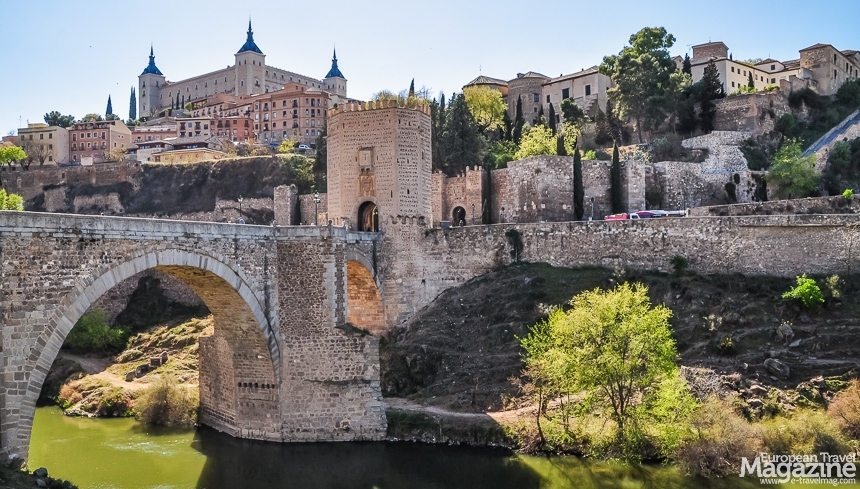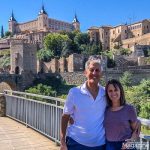Explore Toledo through the eyes of Saul Schwartz, an American traveller discovering the top attractions around Spain’s capital. Wondering what are the must-visit sites in and around Madrid? In this article, Saul finds out if Toledo is worth dedicating an entire day of your travel itinerary and recommends taking a free walking tour to uncover the hidden gems of this World Heritage Site.

By Saul Schwarz
Toledo may be the most popular day trip from Madrid, and most visitors arrive at the beautiful train station. The Toledo train station, built in 1919, reflects the historic architecture of the city. The central section is flanked by two side naves, one of which is adjacent to a clock tower. The interior contains beautiful stained-glass windows, horseshoe shaped arches and ornamented doorways.
From the Toledo train station, it is a very steep one mile walk up to the centre of the city. The walk is very scenic and crosses the Tagus River, the same river we had just seen in Lisbon, Portugal. We walked by architecture from the 16th century and earlier, including the arch style bridge built during Roman times.

We chose Guru Walk for the free tour by tip with our guide. The tour was called Discover the Historical Toledo and the guide Alberto was from Follow Me Toledo. The tour began in Plaza Zocodover, the main square of Toledo. We walked by the bronze statue of Spanish writer Cervantes (author of Don Quixote) and entered the square through a large Moorish style arch topped by a clock tower. The square contains several fast-food chains, but there was a very nice supermarket right off the square where we purchased food for our dinner.
The tour focused upon how three different religions came together in Toledo during different time periods. Toledo is a place made special, in part due to its Christian, Jewish and Muslim roots. We spent some time in front of the Toledo Cathedral and decided to explore the interior after our tour.
We particularly enjoyed learning about the once large Jewish population in Toledo. Although the Jewish population is now small, the 14th century synagogue building has been converted into a museum. The Jewish quarter is where Jews lived in the Middle Ages. We thought it was particularly interesting how the city has installed blue and white tile markers in the pavement and on ancient walls to identify the streets of the Jewish quarter. The markers include a menorah candelabra and the word life written in Hebrew. At one of the entrances to the Jewish quarter, there are inscriptions on the street reading “the Jewish quarter” in English, Hebrew, and Spanish.
The tour ended with a visit to the Casa Palacio Rincon. This 9th century palace house has been converted into rental units but retains some of the charm of the ancient palace.

After our walking tour, we chose to visit the Roman Catholic Cathedral. Tickets are purchased at the ticket office near the Cathedral and cost 10 Euros per adult. The Cathedral is a short walk from Plaza Zocodover. The great Gothic structure is hard to miss!
You may also like to read about:
Construction of the church began in the 13th century and finished in the 15th century. The exterior is a superb example of French Gothic architecture. It is one of the most imposing cathedrals in Spain. The temple was built on top of a Muslim Mosque. To the left of the main façade there is a tower. During our walking tour we learned that the tower contains a large bell that does not function due to a crack. The main façade has three large doors.
The enormous interior contains lovely stained glass rose windows, along with ribbed vaults and pointed arches. The artwork within the church is impressive and includes many works by Spanish artist El Greco. We were also awed by the colourful ceiling frescos.
The high-speed train from Madrid’s Atocha station only takes about thirty minutes and costs 22 Euros for the round trip. The very comfortable high-speed train runs several times daily. We were unable to purchase tickets on-line in advance on the Renfe website using a credit card from the United States. When we went to purchase tickets at the Atocha train station, our time options for that day were limited.
The large Atocha train station is under construction, making it difficult to navigate around. To add to the confusion there are several different Renfe ticket offices but only one sells tickets for the high-speed trains. I recommend allowing extra time to find the right ticket office and arriving early in the day to have more train options.
Saul lives in Alexandria, Virginia and has lived in the Washington, D.C. area since 1984. He loves to travel throughout Europe with his wife and family and particularly enjoys interacting with local residents and learning about life in their city and country.
Saul has previously shared his travel insights with us. Check out his Lisbon 4 Day City guide or check out his trip to Modern Athens – Beyond the Acropolis or his fascination with The Vatican: Rome of the Popes.







